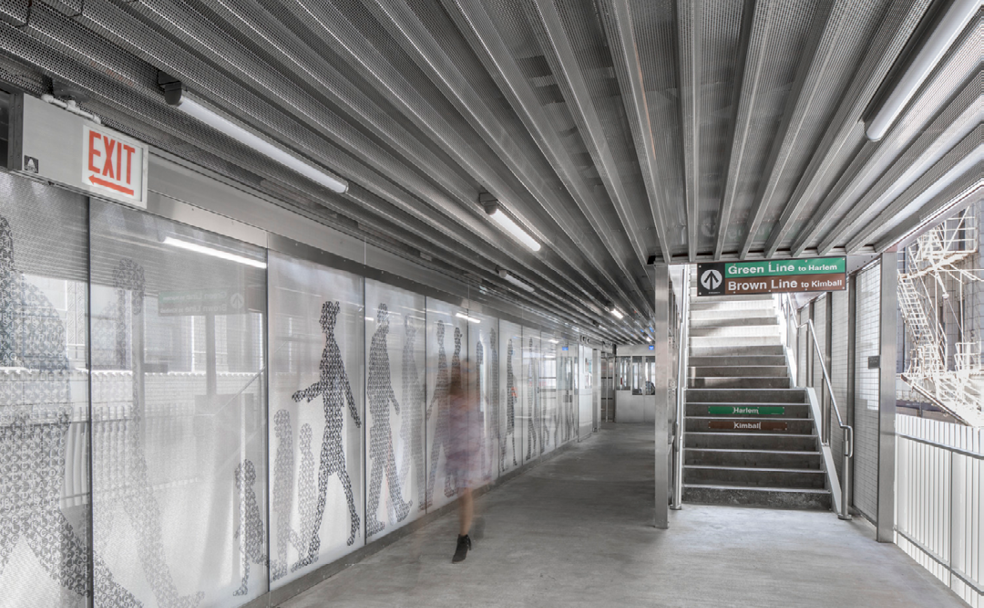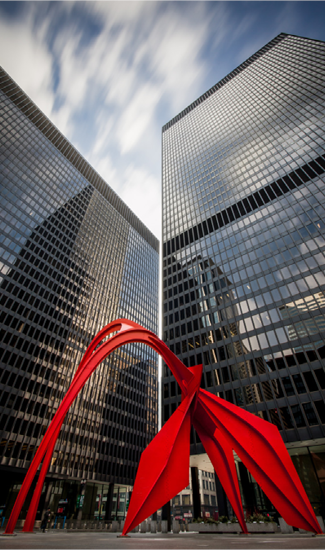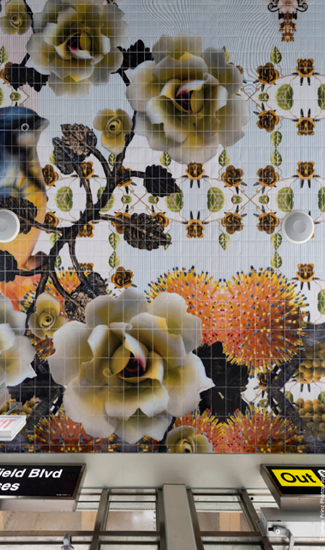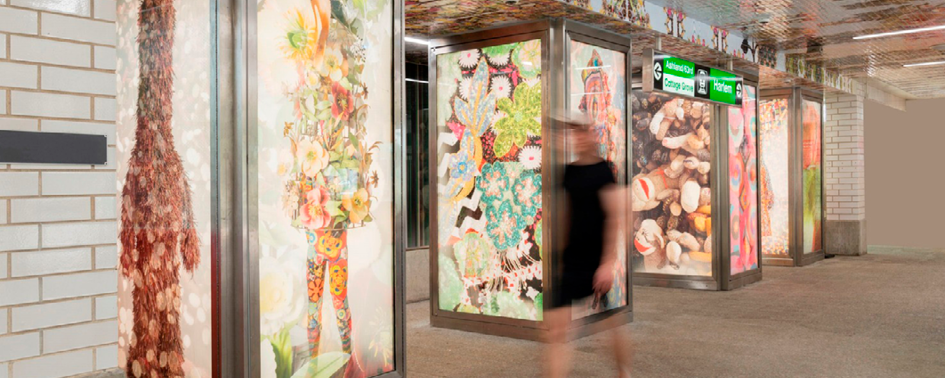By: Sara Fetterolf, Project Architect at EXP
The importance of art and design in public spaces
In public spaces, art plays a crucial role in juxtaposing architecture and offering a new perspective for the viewer. These new perspectives allow individuals to appreciate the nuanced relationship and differences between art and architecture. As the two set the stage for one another, this symbiotic relationship creates meaningful and memorable expressions and experiences.
The collaborative process surrounding these opportunities allow both the artist and the architect to gain inspiration from each other to create something that will impact viewers and the communities they serve. In many cases, architecture becomes art, as seen in many Chicago Transit Authority (CTA) stations, where the sculptural nature of a station creates a memorable experience for the rider. But when art and architecture can work together, that’s where we see the most success.

The process
Incorporating art into public spaces is a multi-dimensional process. One of the steps that should be taken early on is garnering community support or involving local artists from the community itself. This not only fosters a sense of ownership but builds civic pride among the people who are benefitting from the public infrastructure. The concept of place-making usually emerges as a key component during these early conversations, usually focusing on how to create a memorable landmark, statement, or contribution to the surrounding context. When the community and local artists can play a part in shaping this vision and turning what begins as public infrastructure into something they will one day utilize and be proud to walk by every day, it’s a success. Trying to envision those spaces in your mind that achieve this success is usually a helpful guide to finding a set of tools to help direct this vision, and then finding a way to collaborate and merge this with the artist’s voice and shared vision.
There are many different ways that the process evolves, when it comes to actually incorporating the art into the design of the space and/or building. In some instances, the artist and the architect work together after the design has been finalized to incorporate the art in a thoughtful way. But in other instances, we as architects have the opportunity to incorporate art into the DNA of the architecture, by working with the artist early on and involving them into our process as they involve us into theirs. In these instances, there is a lot of room for collaboration and to create something that complements the other in a super supportive way.
“We, as architects have the opportunity to incorporate art into the DNA of the architecture, by working with the artist early on and involving them into our process as they involve us into theirs.”
Challenges to consider
One of the biggest challenges we’ve found is the timing of when artists are brought into the project. Having the artist brought on earlier in the stages with the project proves to be a great way to allow the design and artwork to progress together and in response to one another– so that their initial ideas and voice can inform the work we are doing. Another considerable challenge can be how funding is allocated for public spaces. We are very lucky to have been involved in projects with the CTA and their Public Art Administrator, Lee Kelley, who put a lot of value on the integration of art into public spaces. It is unfortunate that in a lot of other cases, you can see funding for art becoming more of a consideration of what’s left in the bucket at the end of a project and added in last minute. This can disrupt the collaboration process as the architect may not know how to plan for the integration in the later stages of design or may not be able to as fluidly integrate the artist’s voice into their design.
Working alongside artists as architects

Collaborating with artists from the beginning of the design process is an approach that can bring a dynamic integration of architectural and artistic elements. This relationship allows for the distinct voices of both us, as architects and the artist to resonate throughout the project. A notable example of this collaborative energy is exemplified by the Alexander Calder Flamingo sculpture in front of Chicago’s Federal Plaza. Both the Flamingo and the Mies Van Der Rohe Kluczynski Federal Building stand out on their own as incredible pieces of work, but together they complement each other in profound ways. The lines of Mies’ grid style design juxtapose the fluid arcs of Calder’s sculpture, playing off each other and creating a viewing experience for a passersby to appreciate both pieces together at once. That symbiotic relationship of the two pieces is a point of inspiration when it comes to incorporating art into public spaces.
Working with an artist from an early stage of the design process happens in many instances of public spaces that feature art. We’re lucky to have had these opportunities in a few of our projects for the CTA.
With our work on the CTA Green Line Garfield station, we were able to collaborate directly with the two artists on the project – Nick Cave and Bob Faust. As their first station design project with the CTA, they were very involved in including their artwork into the architectural design process – which is evident in the way the art and the architecture play off each other. Nick’s amazing sculptural and soundsuit art is all about movement and social expression, and Bob finds ways to channel that energy and vibrancy into his graphic art expression. When you step into the Garfield Station, the art envelops you and brings you into the mind and experience of the concept of the art. Even though it’s as simple as an application to walls and columns in the station, the experience of using the station brings the artwork to life as you move through it to your destination. Every application of art that was incorporated into the architecture considered the movement that’s inherent to Nick Cave’s work and the movement of the transit rider.
“Every application of art that was incorporated into the architecture considered the movement that’s inherent to Nick Cave’s work and the movement of the transit rider”
Incorporating the community in which the art serves

Building civic or local pride is important when incorporating art into a public space. Involving the community into the decision making and selection process allows for greater place-making across the board and leads to a memorable impact on people. It feels special to prompt people to create memories of spaces and feeling of spaces through this partnership of art and architecture.
With many of our CTA projects, and Garfield specifically, we ask ourselves how we can give the community something that we felt would stand the test of time and would give back to that growing art neighborhood. The whole connection with that community was about ensuring that the art stood out the most – that it wasn’t this art on architecture situation, but rather centering the art to be the focal point. It unfolded as letting the architecture serve as the backdrop and the art be the topic of conversation. Instead of it being a picture on the wall. To create this, we really leaned into community input and collaboration with Nick and Bob, who have made Chicago their home and are involved in various Chicago pursuits. We are proud to be involved in elevating their artistic voice and experience as an artist in Chicago – in a way that the community could appreciate and enjoy every day.

